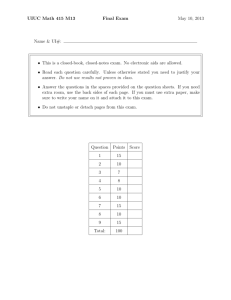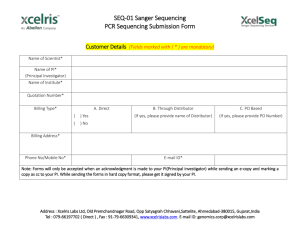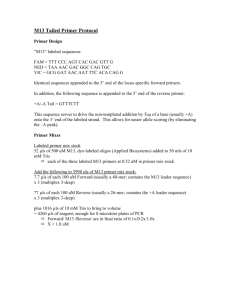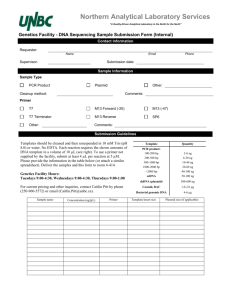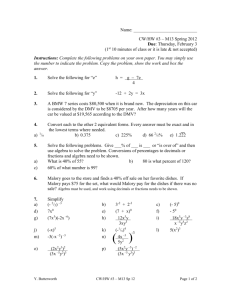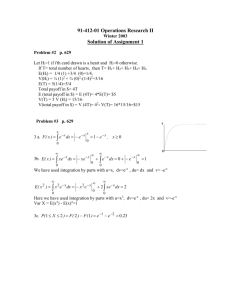A REMARK ABOUT THE CONNES FUSION TENSOR PRODUCT ANDREAS THOM
advertisement
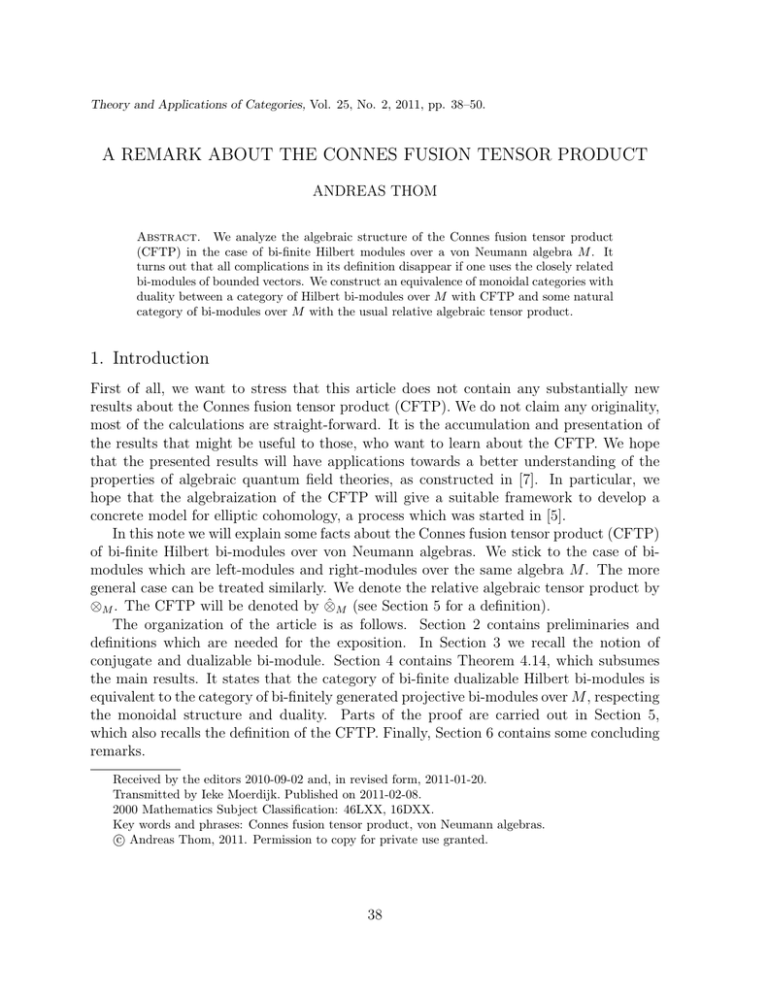
Theory and Applications of Categories, Vol. 25, No. 2, 2011, pp. 38–50.
A REMARK ABOUT THE CONNES FUSION TENSOR PRODUCT
ANDREAS THOM
Abstract. We analyze the algebraic structure of the Connes fusion tensor product
(CFTP) in the case of bi-finite Hilbert modules over a von Neumann algebra M . It
turns out that all complications in its definition disappear if one uses the closely related
bi-modules of bounded vectors. We construct an equivalence of monoidal categories with
duality between a category of Hilbert bi-modules over M with CFTP and some natural
category of bi-modules over M with the usual relative algebraic tensor product.
1. Introduction
First of all, we want to stress that this article does not contain any substantially new
results about the Connes fusion tensor product (CFTP). We do not claim any originality,
most of the calculations are straight-forward. It is the accumulation and presentation of
the results that might be useful to those, who want to learn about the CFTP. We hope
that the presented results will have applications towards a better understanding of the
properties of algebraic quantum field theories, as constructed in [7]. In particular, we
hope that the algebraization of the CFTP will give a suitable framework to develop a
concrete model for elliptic cohomology, a process which was started in [5].
In this note we will explain some facts about the Connes fusion tensor product (CFTP)
of bi-finite Hilbert bi-modules over von Neumann algebras. We stick to the case of bimodules which are left-modules and right-modules over the same algebra M . The more
general case can be treated similarly. We denote the relative algebraic tensor product by
ˆ M (see Section 5 for a definition).
⊗M . The CFTP will be denoted by ⊗
The organization of the article is as follows. Section 2 contains preliminaries and
definitions which are needed for the exposition. In Section 3 we recall the notion of
conjugate and dualizable bi-module. Section 4 contains Theorem 4.14, which subsumes
the main results. It states that the category of bi-finite dualizable Hilbert bi-modules is
equivalent to the category of bi-finitely generated projective bi-modules over M , respecting
the monoidal structure and duality. Parts of the proof are carried out in Section 5,
which also recalls the definition of the CFTP. Finally, Section 6 contains some concluding
remarks.
Received by the editors 2010-09-02 and, in revised form, 2011-01-20.
Transmitted by Ieke Moerdijk. Published on 2011-02-08.
2000 Mathematics Subject Classification: 46LXX, 16DXX.
Key words and phrases: Connes fusion tensor product, von Neumann algebras.
c Andreas Thom, 2011. Permission to copy for private use granted.
⃝
38
39
A REMARK ABOUT THE CONNES FUSION TENSOR PRODUCT
2. Preliminaries
2.1. Hilbert modules and Hilbert bi-modules Throughout the article, let M be
a von Neumann algebra with separable pre-dual. We denote by M op the von Neumann
algebra, which is defined to be M as complex vector space, but with the opposite multiplication. A Hilbert space H, which is at the same time a left-module over M , is called
a Hilbert left-module over M , if the module action is induced by a normal, ∗-preserving,
and unital homomorphism M → B(H). A Hilbert right-module is defined similarly with
M op in place of M . A Hilbert bi-module over M is a Hilbert space H which is at the same
time a Hilbert left-module and a Hilbert right-module over M , such that the actions of
M and M op commute.
Let ϕ : M → C be a faithful and normal state. The assignment (x, y) 7→ ϕ(y ∗ x)
makes M into a pre-Hilbert space, whose completion we denote by L2ϕ (M ). We denote
the image of an element x ∈ M under the natural inclusion M ⊂ L2ϕ (M ) by x̂ ∈ L2ϕ (M ).
Furthermore, we use the convention Ω = 1̂.
The Hilbert space L2ϕ (M ) is naturally a Hilbert left-module, since
∥y x̂∥2L2 (M ) = ∥yx∥
ˆ 2L2 (M ) = ϕ(x∗ y ∗ yx) ≤ ∥y∥2 ϕ(x∗ x) = ∥y∥2 ∥x∥2L2 (M ) ,
ϕ
ϕ
ϕ
so that left-multiplication by y extends to a bounded operator on the completion.
In Tomita-Takesaki theory (see [6, Ch. VI-VIII]), an operator S is considered. It is
defined as the closure of the conjugate linear assignment
b̂ 7→ bˆ∗ .
In general S is an unbounded operator. Its polar decomposition S = J∆1/2 is such that
J is a conjugate-linear isometry and ∆1/2 is an unbounded, positive operator.
We define a right-module structure by setting ξ b = J(b∗ (Jξ)). It follows from
Tomita-Takesaki theory that the left and right-module structure are commutants of each
other, so that in particular, they give L2ϕ (M ) the structure of a Hilbert bi-module.
The Hilbert space L2ϕ (M )⊕n is at the same time a Hilbert left-module over M and a
Hilbert right-module over Mn (M ). Again, these actions are commutants of each other. A
similar remark applies to the obvious left-module structure over Mn (M ) and the diagonal
action of M on the right. We will freely use these actions without further notational
complication.
A Hilbert left-module H is called finitely generated, if there is a bounded surjection
of left-modules from L2ϕ (M )⊕n to H, for some n ∈ N. By polar decomposition, we can
assume that the surjection is a partial isometry. A similar definition applies to rightmodules. A Hilbert bi-module is called bi-finite, if it is finitely generated as left-module
and as right-module.
By definition, all finitely generated Hilbert left-modules over M are unitarily equivalent
⊕n
to L2ϕ (M ) p, for some n ∈ N and some projection p ∈ Mn (M ).
The algebra M is itself a bi-module over M , but usually not a Hilbert space. However,
it is finitely generated projective as left and as right module. Recall: a module is projective, if it is a direct summand in a free module. In the sequel, we will encounter finitely
40
ANDREAS THOM
generated projective modules over M , which are associated to bi-finite Hilbert modules
over M .
Let H and L be Hilbert left-modules (resp. right-modules). We denote by
homM − (H, L) (resp.
hom−M (H, L))
the vector space of bounded left-module maps (resp. right module maps).
Let H and L be either (Hilbert) left-modules, right-modules or bi-modules over M .
The algebraic direct sum of the vectorspaces H and L carries obvious module structures,
such that H ⊕ L is categorical sum in the categories of (Hilbert) left-modules, rightmodules and bi-modules over M , respectively.
2.2. Modules of homomorphisms Let H and L be Hilbert bi-modules. We consider
hom−M (H, L) and homM − (H, L). There are natural bi-module structures on these vector
spaces. For x ∈ hom−M (H, L), b ∈ M and ξ ∈ H, we define
(b x)(ξ) = b x(ξ) and (x b)(ξ) = x(b ξ).
Similarly, for x ∈ homM − (H, L), b ∈ M and ξ ∈ H, we define
(b x)(ξ) = x(ξ b) and (x b)(ξ) = x(ξ) b.
It is an easy check, that these formula indeed define bi-module structures. The adjoint of
x ∈ hom−M (H, L) (resp. x ∈ homM − (H, L)) is denoted by x∗ ∈ hom−M (L, H) (resp. x∗ ∈
homM − (L, H)). It satisfies (x(ξ), η)L = (ξ, x∗ (η))H . Concerning the module structure, we
have (in either case)
(b x)∗ = x∗ b∗
and (x b)∗ = b∗ x∗ .
(1)
Note that there is a canonical isomorphism
α : hom−M (L2ϕ (M ), L2ϕ (M )) → M
of von Neumann algebras and bi-modules over M . We have α(x) ξ = x(ξ), for x ∈
hom−M (L2ϕ (M ), L2ϕ (M )). Similarly, there is a canonical isomorphism
α′ : homM − (L2ϕ (M ), L2ϕ (M )) → M,
of bi-modules which satisfies x(ξ) = ξ α′ (x).
2.3. Definition. Let H be a Hilbert bi-module. We define the bi-module of left-bounded
vectors by D(H, ϕ) = hom−M (L2ϕ (M ), H).
There is a similar definition for right-bounded vectors in terms of left-module maps. In
the case of dualizable modules, we will show in Theorem 3.6, that the left-bounded and
right-bounded vectors are naturally isomorphic as bi-modules over M .
A REMARK ABOUT THE CONNES FUSION TENSOR PRODUCT
41
3. Duality
3.1. Conjugate bi-modules Let H be a bi-module over M . We denote by H the
conjugate bi-module. It is defined to be H as a real linear space, but equipped with
the conjugate complex structure. Denote the image of ξ ∈ H (under the real linear
identification) in H by ξ. We define a bi-module structure over M by b ξ = ξ b∗ and
ξ b = b∗ ξ. If H is a Hilbert bi-module, then H is naturally a Hilbert bi-module,
taking (ξ, η)H = (ξ, η)H . Note that H is bi-finite if and only if H is bi-finite.
3.2. Proposition. There is a natural unitary isomorphism of bi-modules over M
∼
β : L2ϕ (M ) → L2ϕ (M ).
Proof. The map β is given by
m̂ 7→ Ω m∗ = J(m̂).
It is unitary since J is a conjugate-linear isometry.
In the sequel we provide some isomorphisms between modules of homomorphisms.
3.3. Proposition. Let H and L be Hilbert bi-modules over M . We have a natural
isomorphism
∼
hom−M (K, H) → hom−M (H, K)
of bi-modules over M . Similarly, there is an isomorphism
∼
homM − (K, H) → homM − (H, K)
of bi-modules over M .
Proof. The map is given by the assignment x 7→ x∗ . Using Equations 1, it is easily
checked that this is map of bi-modules.
3.4. Proposition. There is a natural isomorphism
∼
homM − (H, K) → hom−M (H, K),
of bi-modules over M .
Proof. The map is given by x 7→ x† , where x† (ξ) = x(ξ).
The next computations show, that it is indeed an isomorphism of bi-modules. We
have
(b x)† (ξ) = b x(ξ) = x(ξ) b∗ ,
so that
(b x)† = x† b∗ = b x† .
Similarily,
(x b)† (ξ) = (x b)(ξ) = x(b ξ) = x(ξ b∗ ),
so that
(x b)† = b∗ x† = x† b.
42
ANDREAS THOM
Putting Proposition 3.3 and Proposition 3.4 together, we get a natural isomorphism
of bi-modules as follows.
∼
hom−M (L, H) → homM − (H, L).
(2)
A case of special interest is the case L = L2ϕ (M ). Composing with the inverse of
∼
the isomorphism β : L2ϕ (M ) → L2ϕ (M ) yields an identification of bi-modules over M as
follows:
∼
hom−M (L2ϕ (M ), H) → homM − (H, L2ϕ (M )).
(3)
Making everything explicit, the image of x ∈ hom−M (L2ϕ (M ), H) is denoted by x′ and
x′ (ξ) = Jx∗ (ξ).
3.5. Dual modules In order to speak about duality, we need a monoidal category (for
definitions see [3, Ch. VII]) . The category of Hilbert bi-modules over M is equipped with
the Connes fusion tensor product (CFTP) which makes it into a monoidal category. We
will give a definition of the CFTP and a proof of the preceding assertion in Section 5 and
freely use its existence in this section. Section 5 is independent of the results obtained in
this section.
Let H be a Hilbert bi-module. A dual of H is a Hilbert module H ′ , together with
ˆ M H ′ → L2ϕ (M ) and εH : L2ϕ (M ) → H ′ ⊗
ˆ M H, which satisfy the usual
morphisms ηH : H ⊗
adjointness relations, i.e.
ˆ M ε) ◦ (ηH ⊗
ˆ M idH ) = idH
(idH ⊗
ˆ M idH ′ ) ◦ (idH ′ ⊗
ˆ M ηH ) = idH ′ .
and (ε ⊗
We call a Hilbert bi-module H dualizable, if H is a dual of H. (A similar definition
applies to bi-modules over M with respect to the relative algebraic tensor product.)
The notion of duality is self-dual. Thus, if H is dualizable, then so is H, we have
εH = ηH ∗ and ηH = εH ∗ .
The duality gives a natural identification of bi-modules
∼
homM − (L2ϕ (M ), H) → homM − (H, L2ϕ (M ))
(4)
ˆ M idH ). This yields the following theorem.
via the assignment φ 7→ ηH ◦ (φ ⊗
3.6. Theorem. If H is dualizable, then there is a natural isomorphism of bi-modules
∼
hom−M (L2ϕ (M ), H) → homM − (L2ϕ (M ), H).
Proof. This follows from the isomorphisms in formula 3 and 4.
A REMARK ABOUT THE CONNES FUSION TENSOR PRODUCT
43
4. Main theorem
4.1. Finiteness There is a natural linear inclusion map D(H, ϕ) 7→ H which is given by
x 7→ x(Ω). It is a map of left modules over M , but in general not a map of right modules.
If H is a Hilbert bi-module, finitely generated as a Hilbert right-module over M ,
it is isomorphic to p L2ϕ (M )⊕n as a right module, for some n ∈ N and projection
p ∈ Mn (M ). We easily get that D(H, ϕ) = pM ⊕n as right-modules. Indeed, this follows
since H 7→ hom−M (L2ϕ (M ), H) (seen as a right-module) is functorial for right-module
maps and preserves direct sums. Thus, D(H, ϕ) is finitely generated projective as a rightmodule.
If H is dualizable, we find a similar argument showing that D(H, ϕ) is finitely generated
projective as a left-module. Indeed, this follows from Theorem 3.6.
4.2. Proposition. If H is a dualizable bi-finite Hilbert module over M , then D(H, ϕ) is
finitely generated projective as left-module and as right-module over M .
4.3. Definition. A bi-module over M which is finitely generated projective as a rightmodule and as a left-module is called a bfgp bi-module over M .
The term ’bfgp’ encodes the words bi-finitely generated projective.
4.4. Definition. We denote by HM the category of Hilbert bi-modules over M and by
d
HM
the category of bi-finite dualizable Hilbert bi-modules over M . The morphisms in HM
d
and HM
are defined to be bounded maps of bi-modules.
4.5. Inner products Let H be a bi-finite Hilbert bi-module over M . The bi-modules
of the form D(H, ϕ) have an additional feature, they carry a M -valued inner product,
which is given by the formula
(x, y) = α(y ∗ x).
In general, a M -valued inner product is a real linear map H × H → M , which is complex
linear in the first variable and satisfies
(x, y) = (y, x)∗
and (x, x) ≥ 0,
for all x, y ∈ H.
A M -valued inner product of a bi-module H is called complete if the norm x 7→
∥(x, x)1/2 ∥ is complete. It is called compatible with the module actions, if
(b x, y) = (x, b∗ y)
(x b, y) = (x, y)b.
4.6. Proposition. Let M be a bfgp bi-module over M . There exists a complete and
compatible M -valued inner product on M .
44
ANDREAS THOM
Proof. Let H be a bfgp bi-module over M . Again, H is isomorphic to pM ⊕n as rightmodule, for some n ∈ N and p ∈ Mn (M ). We define an inner product on H by setting
n
((bi )ni=1 , (b′ i=1 ))
=
n
∑
∗
b′ i bi .
i=1
One easily checks that this inner product is complete and compatible. However, a choice
was involved.
4.7. Proposition. Let H be a bi-finite dualizable Hilbert bi-module. The bi-module
D(H, ϕ) is bfgp and the canonical M -valued inner product on D(H, ϕ) is complete and
compatible.
Proof. The first part is Proposition 4.2. Compatibility and completeness are easily
checked.
If H and K are bi-modules over M , which carry an inner product, then there is a
natural inner product on H ⊗M K, given by the formula
(x1 ⊗ y1 , x2 ⊗ y2 )H⊗M K = ((x1 , x2 )H y1 , y2 )K .
4.8. Proposition. Every bfgp bi-module over M is dualizable as a bi-module.
Proof. First of all, note that the statement of the proposition is purely algebraic, i.e.
the concept of duality is the usual duality of bi-modules w.r.t. to the relative algebraic
tensor product.
The duality is induced by the inner product, but let us first start with a plain bfgp
bi-module H over M and let us show that hom−M (H, M ) is a dual of H. First of all,
there is a map ηH : hom−M (H, M ) ⊗M H → M , given by ϕ ⊗ h 7→ ϕ(h).
The other structure map of the duality εM : M → H ⊗M hom−M (H, M ) is described
by some central element in H ⊗ hom−M (H, M ). Note, that H embeds in M ⊕n as rightmodule, with projection p ∈ Mn (M ), such that
∼
H ⊗M hom−M (H, M ) ⊂ M ⊕n ⊗M hom−M (M ⊕n , M ) → M ⊕n
2
Here, H ⊗M hom−M (H, M ) identifies, as a complex vector space, with pMn (M )p and
the bi-module structure is given by one normal, unital and ∗-preserving homomorphism
γ : M → pMn (M )p. Clearly, p ∈ pMn (M )p is a central element, so that a morphism of
bi-modules εM : M 7→ H ⊗M hom−M (H, M ) can be defined. One easily checks, that the
adjointness conditions are fulfilled, so that H is indeed a dual of hom−M (H, M ).
Consider now a choice of a M -valued inner product on H which exists by Proposition
4.6. We get a natural map of bi-modules H 7→ hom−M (H, M ), which is given by k 7→
{H ∋ h 7→ (h, k)H ∈ M }. One easily shows that it is an isomorphism. Thus, H is a dual
of H, for any bfgp bimodule. This implies the assertion.
A REMARK ABOUT THE CONNES FUSION TENSOR PRODUCT
45
4.9. Categories of bi-modules
4.10. Definition. The category of bi-modules over M is denoted by BM . Denote the
category of bfgp bi-modules over M by FM . Furthermore, denote the category of bfgp
∗
bi-modules with a choice of a complete and compatible inner product by FM
. In either
case, morphisms are bi-module maps.
∗
If follows from Proposition 4.6, that the forgetful functor FM
→ FM is an equivalence
of categories , although there is no canonical inverse equivalence.
The assignment H 7→ D(H, ϕ) extends to a functor Dϕ : HM → BM from the category
of Hilbert bi-modules over M to the category of bi-modules over M . We have shown in
d
∗
Proposition 4.7 that this functor descents to a functor Dϕ : HM
→ FM
, from the category
of bi-finite Hilbert bi-modules over M to the category of bfgp bi-modules with complete
and compatible inner products over M .
Let H be a bfgp bi-module over M with complete and compatible inner product. The
relative tensor product H ⊗M L2ϕ (M ) is naturally a bi-finite Hilbert bi-module. Its inner
product is computed by the equation
(h ⊗ ξ, h′ ⊗ η) = ((h, h′ )H ξ, η)L2ϕ (M ) .
At the moment we leave the assertion open, that this construction produces dualizable
modules. It will become apparent after the definition of CFTP. We will assume the
assertion for the rest of the section.
∗
d
4.11. Lemma. There is a functor L2ϕ : FM
→ HM
, which sends H 7→ H ⊗M L2ϕ (M ).
We continue by proving two propositions that show that the functors L2ϕ and Dϕ are
actually equivalences of categories.
4.12. Proposition. Let H be a bi-finite Hilbert bi-module over M . There is a natural
unitary equivalence
∼
D(H, ϕ) ⊗M L2ϕ (M ) → H
of Hilbert bi-modules over M .
Proof. First of all, we define a map D(H, ϕ) ⊗C L2ϕ (M ) → H by sending
x ⊗ ξ 7→ x(ξ).
This clearly falls to a map from the relative tensor product over M . It is a map of
left-modules, since b (x ⊗ ξ) = (b x) ⊗ ξ 7→ (b x)(ξ) = b (x(ξ)).
Again, the map is a unitary equivalence if H is isomorphic to L2ϕ (M )⊕n , and hence if H
is any finitely generated Hilbert module. The assertion about the right-module structure
follows similarily.
46
ANDREAS THOM
4.13. Proposition. Let H be a bfgp bi-module with complete and compatible inner product. We have a natural isomorphism
∼
H → hom−M (L2ϕ (M ), H ⊗M L2ϕ (M ))
of bfgp bi-modules with inner product.
Proof. Let h be an element in H. We define a map h′ : L2ϕ (M ) → H ⊗M L2ϕ (M ) by
sending ξ 7→ h ⊗ ξ. The assignment h 7→ h′ is clearly a map of right-modules. Again, it
is an isomorphism if H = M ⊕n , as right-modules, and hence for any bfgp bi-module by
functoriality of the above assignment for right-modules. We still have to give an argument
that shows that the inner products match. First of all, we compute the adjoint of h′ . We
claim that h′ ∗ (k ⊗ η) = (h, k)∗M η, for k ∈ H and η ∈ L2ϕ (M ).
(h′ (ξ), k ⊗ η)H⊗M L2ϕ (M ) = (h ⊗ ξ, k ⊗ η)H⊗M L2ϕ (M )
= ((h, k)H ξ, η)L2ϕ (M )
= (ξ, (h, k)H ∗ η)L2ϕ (M )
= (ξ, h′ (k ⊗ η))L2ϕ (M )
But clearly,
∗
(h′ (ξ), k ⊗ η)H⊗M L2ϕ (M ) = (ξ, h′ k(η))L2ϕ (M )
∗
= (ξ, α(k ′ h′ )∗ η)L2ϕ (M ) ,
so that α(k ′ ∗ h′ ) = (h, k)M and the assertion follows.
The above propositions imply part of the following theorem.
∗
d
d
∗
4.14. Theorem. The functors L2ϕ : FM
→ HM
and Dϕ : HM
→ FM
constitute an
equivalence of monoidal categories with duality.
We claim, that these functors extends to an equivalence of tensor categories. The
above propositions show that these functors are at least equivalences of categories. In
order to make the remaining assertion precise, we recall the definition and some facts
about the CFTP. The proof Theorem 4.14 will be finished in Section 5.
The above result should be compared with Theorem 6.24 in [2]. Our methods allow
to prove Theorem 6.24 in the context of not necessarily finite von Neumann algebras.
However, since we stick to bi-modules Theorem 4.14 does not imply Theorem 6.24 in [2]
and thus cannot be seen in complete analogy. Since we know of no interesting applications
of left-modules (rather that bi-modules) over infinite von Neumann algebras, we leave this
issue aside.
A REMARK ABOUT THE CONNES FUSION TENSOR PRODUCT
47
5. The Connes fusion tensor product
5.1. Definition The CFTP makes makes the category of Hilbert bi-modules over M
into a monoidal category. It is defined as follows. Let H and K be bi-finite Hilbert
bi-modules over M . D(H, ϕ) ⊗C D(K, ϕ) carries a pre-inner product, given by
(x1 ⊗ y1 , x2 ⊗ y2 ) = ϕ(α(y2∗ (α(x∗2 x1 ) y1 ))).
The CFTP of H and K over M is defined to be, as a Hilbert space, the completion of
ˆ M K.
D(H, ϕ)⊗C D(K, ϕ) with respect to the pre-inner product above. It is denoted by H ⊗
The following computation shows that the usual algebraic tensor relations lie in the
null-space of the inner product.
((x1 b) ⊗ y1 , x2 ⊗ y2 ) = ϕ(α(y2∗ (α(x∗2 (x1 b)) y1 )))
= ϕ(α(y2∗ (α(x∗2 x1 ) (b y1 )))
= (x1 ⊗ (b y1 ), x2 ⊗ y2 )
This implies that the CFTP is actually the completion of D(H, ϕ) ⊗M D(K, ϕ). The
ˆ M K still has to be specified. The left-module structure is the
module structure on H ⊗
one that is extended by the completion. However, the right-module structure is the one
ˆM K
coming from K, rather that D(K, ϕ). The following alternative description of H ⊗
will make this apparent.
In the literature, there are several other definitions and formulas for the inner product
which have caused some confusion, in particular to those who wanted to understand the
CFTP from a purely algebraic point of view. We want to review the definition of Connes
and Sauvageot [1, 4] and the definition of Wassermann [7].
5.2. The definitions of Connes and Wassermann In [1, 4], A. Connes and later
J.-L. Sauvageot considered an inner product on D(H, ϕ) ⊗ K. It is given by the formula
(x1 ⊗ ξ1 , x2 ⊗ ξ2 )′ = (α(x∗2 x1 ) ξ1 , ξ2 )K .
On vectors ξi , which are of the form yi (Ω), for some yi ∈ D(K, ϕ), this reads as follows:
(x1 ⊗ y1 (Ω), x2 ⊗ y2 (Ω))′ = ((α(x∗2 x1 ) y1 )(Ω), y2 (Ω))K
= ((y2∗ ((α(x∗2 x1 ) y1 )(Ω), Ω)L2ϕ (M )
= ϕ(α(y2∗ (α(x∗2 x1 ) y1 )))
= (x1 ⊗ y1 , x2 ⊗ y2 ).
We get that the inclusion D(H, ϕ) ⊗C D(K, ϕ) ⊂ D(H, ϕ) ⊗C K is isometric (with
respect to the pre-inner products) and hence the completions are isometric.
In [7] A. Wassermann defines the CFTP of Hilbert bi-modules H and K over M as a
completion of hom−M (L2ϕ (M ), H)⊗C homM − (L2ϕ (M ), K) with respect to the inner product
48
ANDREAS THOM
(x1 ⊗ y1 , x2 ⊗ y2 )′′ = (α(x∗2 x1 ) Ω α′ (y2∗ y1 ), Ω)L2ϕ (M ) ,
which he calls a four-point formula.
The following computation implies that the completion of the natural morphism
hom−M (L2ϕ (M ), H) ⊗C homM − (L2ϕ (M ), K) → D(H, ϕ) ⊗C K
is isometric with respect to the pre-inner products. Furthermore, it has dense image.
Therefore, the completion is an isometric isomorphism.
(x1 ⊗ y1 (Ω), x2 ⊗ y2 (Ω))′ = (α(x∗2 x1 ) y1 (Ω), y2 (Ω))L2ϕ (M )
= (y2∗ (α(x∗2 x1 ) y1 (Ω)), Ω)L2ϕ (M )
= (α(x∗2 x1 ) y2∗ y1 (Ω), Ω)L2ϕ (M )
= (x1 ⊗ y1 , x2 ⊗ y2 )′′
ˆ M K is not defined as a completion of the algebraic tensor
Note, that in either case H ⊗
product H ⊗C K.
5.3. Some properties From the definition above, it is already clear that
ˆM H
L2ϕ (M ) ⊗
ˆ M L2ϕ (M )
H⊗
∼
= H
∼
= H,
and
ˆM L
(H ⊕ K) ⊗
ˆ M (K ⊕ L)
H⊗
∼
ˆ M L) ⊕ (K ⊗
ˆ M L)
= (H ⊗
∼
ˆ M K) ⊕ (H ⊗
ˆ M L)
= (H ⊗
for all Hilbert bi-modules H, K and L over M .
5.4. Proposition. Let K and H be bi-finite Hilbert bi-modules. There is a natural
isomorphism
ˆ M H) = D(K ⊗
ˆ M H, ϕ)
D(K, ϕ) ⊗M D(H, ϕ) → hom−M (L2ϕ (M ), K ⊗
(5)
of bi-modules over M .
Proof. The map is given by completing the map M → D(K, ϕ) ⊗M D(H, ϕ), which is
associated to an element in x ⊗ y ∈ D(K, ϕ) ⊗M D(H, ϕ). It is described by
m 7→ x ⊗ (y m),
and extends to L2ϕ (M ) since
∥x ⊗ (y m)∥2 = ϕ(m∗ α(y ∗ (α(x∗ x) y))m)
≤ ∥α(y ∗ (α(x∗ x) y)∥ ϕ(m∗ m)
= C ∥m̂∥2L2 (M ) .
ϕ
A REMARK ABOUT THE CONNES FUSION TENSOR PRODUCT
49
The arrow in Equation 5 is an isomorphism, if K is isomorphic, as a right-module, to
and hence if K is any bi-finite Hilbert bi-module over M , by functoriality for
maps of Hilbert right-modules in the left variable.
L2ϕ (M )⊕n ,
Proposition 5.4 implies the associativity of the CFTP for bi-finite Hilbert bi-modules.
Indeed, we can transport the associativity isomorphisms from the category F ∗ . It is
∗
now obvious that the equivalence of categories between HM and FM
is an equivalence
of monoidal categories. Indeed, we have shown the existence of natural isomorphisms
∼
ˆ M H), compatible with the monoidal structure maps. It
Dϕ (K) ⊗M Dϕ (H) → Dϕ (K ⊗
follows by abstract reasoning, that the functor L2ϕ also preserves the monoidal structure.
The next proposition makes this explicit.
5.5. Proposition. There is a natural isomorphism
∼
ˆ M (H ⊗M L2ϕ (M )),
K ⊗M H ⊗M L2ϕ (M ) → (K ⊗M L2ϕ (M )) ⊗
compatible with the monoidal structure maps.
Proof. The map is given by k ⊗ h ⊗ m̂ 7→ k ⊗ (h m). Again, we can show that this
map extends to an isomorphism of Hilbert bi-modules.
In the proof of Theorem 4.14, we left open the assertion, that the functors Dϕ and
L2ϕ preserve duality. We still have to show that the image of the functor L2ϕ consists of
dualizable modules.
Let H be a Hilbert bi-module and H its dual. There is are natural isomorphisms of
bi-modules over M
D(H, ϕ) ∼
= hom−M (L2ϕ (M ), H)
∼
= homM − (L2 (M ), H)
ϕ
∼
= homM − (L2ϕ (M ), H)
∼
= hom−M (L2ϕ (M ), H).
Here we used, Proposition 3.4, Proposition 3.2 and Theorem 3.6.
This shows, that the functor Dϕ and hence L2ϕ preserve conjugacy of modules, up
to natural isomorphism. We showed in Proposition 5.4 that it preserves the monoidal
structure up to natural isomorphism. This implies that L2ϕ actually maps dualizable bimodules to dualizable Hilbert bi-modules. Since all bfgp bi-modules are dualizable, the
desired assertion is proven.
6. Conclusion
One might draw the conlcusion that all monoidal categories appearing in the realm of von
Neumann algebras and satisfying the usual finiteness assumptions, can be understood
50
ANDREAS THOM
from a completely algebraic point of view. This point is surely well-known to the experts
in the field. We still believe that it will be helpful to those, that start working in conformal
field theory, subfactors (especially of von Neumann factors of type III) etc.
There is no reason to be scared by the CFTP. This was maybe part of the confusion
related to it.
References
[1] A. Connes, Non-commutative geometry, Academic Press (1994)
[2] W. Lück, L2 -Invariants: Theory and Applications to Geometry and K-theory,
Springer Verlag (2002)
[3] S. MacLane, Categories for the working mathematician, Springer Verlag (1971)
[4] J.-L. Sauvogeot, Sur le produit tensoriel relatif d’espace d’Hilbert, Journal of Operator Theory 9 (1983), 237-252
[5] S. Stolz, P. Teichner, What is an elliptic object?, Topology, geometry and quantum
field theory, LMS 308, Cambridge University Press (2004), 247-343,
[6] M. Takesaki, Theory of Operator algebras II, Encyclopaedia of Mathematical Sciences 125, Springer Verlag, (2003)
[7] A. Wassermann, Operator algebras and conformal field theory III, Inventiones Mathematicae 133 (1998), 467-538
Universität Leipzig, Germany
Email: thom@math.uni-leipzig.de
This article may be accessed at http://www.tac.mta.ca/tac/ or by anonymous ftp at
ftp://ftp.tac.mta.ca/pub/tac/html/volumes/25/2/25-02.{dvi,ps,pdf}
THEORY AND APPLICATIONS OF CATEGORIES (ISSN 1201-561X) will disseminate articles that
significantly advance the study of categorical algebra or methods, or that make significant new contributions to mathematical science using categorical methods. The scope of the journal includes: all areas of
pure category theory, including higher dimensional categories; applications of category theory to algebra,
geometry and topology and other areas of mathematics; applications of category theory to computer
science, physics and other mathematical sciences; contributions to scientific knowledge that make use of
categorical methods.
Articles appearing in the journal have been carefully and critically refereed under the responsibility of
members of the Editorial Board. Only papers judged to be both significant and excellent are accepted
for publication.
Full text of the journal is freely available in .dvi, Postscript and PDF from the journal’s server at
http://www.tac.mta.ca/tac/ and by ftp. It is archived electronically and in printed paper format.
Subscription information Individual subscribers receive abstracts of articles by e-mail as they
are published. To subscribe, send e-mail to tac@mta.ca including a full name and postal address. For institutional subscription, send enquiries to the Managing Editor, Robert Rosebrugh, rrosebrugh@mta.ca.
The typesetting language of the journal is TEX, and LATEX2e
strongly encouraged. Articles should be submitted by e-mail directly to a Transmitting Editor. Please
obtain detailed information on submission format and style files at http://www.tac.mta.ca/tac/.
Information for authors
Managing editor Robert Rosebrugh, Mount Allison University: rrosebrugh@mta.ca
TEXnical editor Michael Barr, McGill University: barr@math.mcgill.ca
Assistant TEX editor Gavin Seal, Ecole Polytechnique Fédérale de Lausanne:
gavin seal@fastmail.fm
Transmitting editors
Clemens Berger, Université de Nice-Sophia Antipolis, cberger@math.unice.fr
Richard Blute, Université d’ Ottawa: rblute@uottawa.ca
Lawrence Breen, Université de Paris 13: breen@math.univ-paris13.fr
Ronald Brown, University of North Wales: ronnie.profbrown(at)btinternet.com
Aurelio Carboni, Università dell Insubria: aurelio.carboni@uninsubria.it
Valeria de Paiva: valeria.depaiva@gmail.com
Ezra Getzler, Northwestern University: getzler(at)northwestern(dot)edu
Martin Hyland, University of Cambridge: M.Hyland@dpmms.cam.ac.uk
P. T. Johnstone, University of Cambridge: ptj@dpmms.cam.ac.uk
Anders Kock, University of Aarhus: kock@imf.au.dk
Stephen Lack, Macquarie University: steve.lack@mq.edu.au
F. William Lawvere, State University of New York at Buffalo: wlawvere@buffalo.edu
Tom Leinster, University of Glasgow, Tom.Leinster@glasgow.ac.uk
Jean-Louis Loday, Université de Strasbourg: loday@math.u-strasbg.fr
Ieke Moerdijk, University of Utrecht: moerdijk@math.uu.nl
Susan Niefield, Union College: niefiels@union.edu
Robert Paré, Dalhousie University: pare@mathstat.dal.ca
Jiri Rosicky, Masaryk University: rosicky@math.muni.cz
Brooke Shipley, University of Illinois at Chicago: bshipley@math.uic.edu
James Stasheff, University of North Carolina: jds@math.unc.edu
Ross Street, Macquarie University: street@math.mq.edu.au
Walter Tholen, York University: tholen@mathstat.yorku.ca
Myles Tierney, Rutgers University: tierney@math.rutgers.edu
Robert F. C. Walters, University of Insubria: robert.walters@uninsubria.it
R. J. Wood, Dalhousie University: rjwood@mathstat.dal.ca
